Attached files
| file | filename |
|---|---|
| 8-K - FORM 8-K - ACI WORLDWIDE, INC. | c63051e8vk.htm |
| EX-99.1 - EX-99.1 - ACI WORLDWIDE, INC. | c63051exv99w1.htm |
Exhibit 99.2
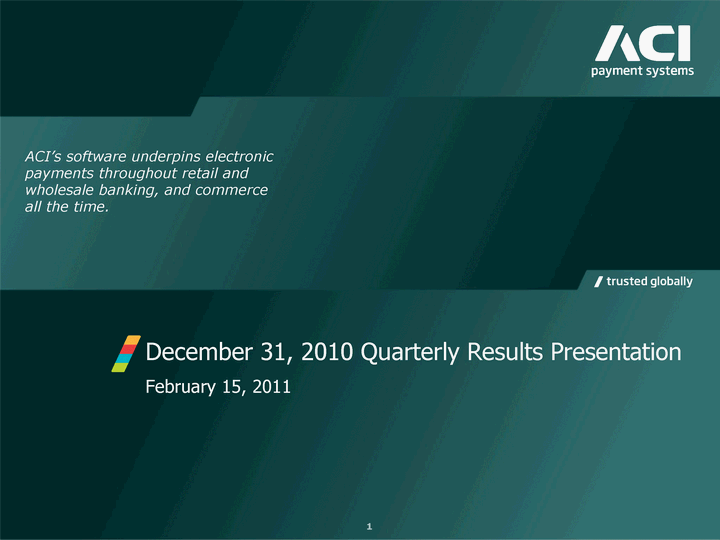
| February 15, 2011 December 31, 2010 Quarterly Results Presentation 1 ACI's software underpins electronic payments throughout retail and wholesale banking, and commerce all the time. |
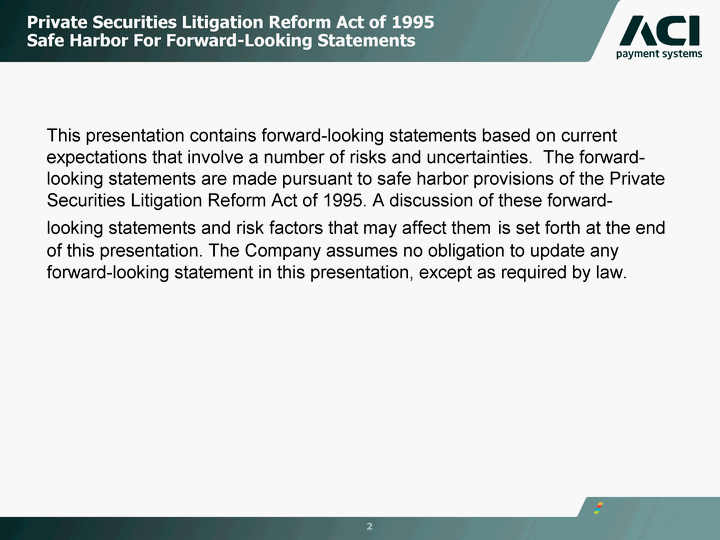
| This presentation contains forward-looking statements based on current expectations that involve a number of risks and uncertainties. The forward- looking statements are made pursuant to safe harbor provisions of the Private Securities Litigation Reform Act of 1995. A discussion of these forward- looking statements and risk factors that may affect them is set forth at the end of this presentation. The Company assumes no obligation to update any forward-looking statement in this presentation, except as required by law. Private Securities Litigation Reform Act of 1995 Safe Harbor For Forward-Looking Statements |
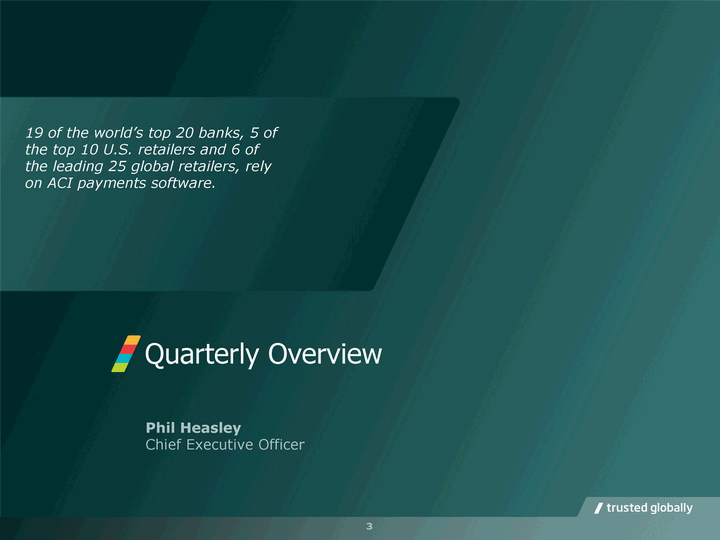
| Quarterly Overview 19 of the world's top 20 banks, 5 of the top 10 U.S. retailers and 6 of the leading 25 global retailers, rely on ACI payments software. Phil Heasley Chief Executive Officer |
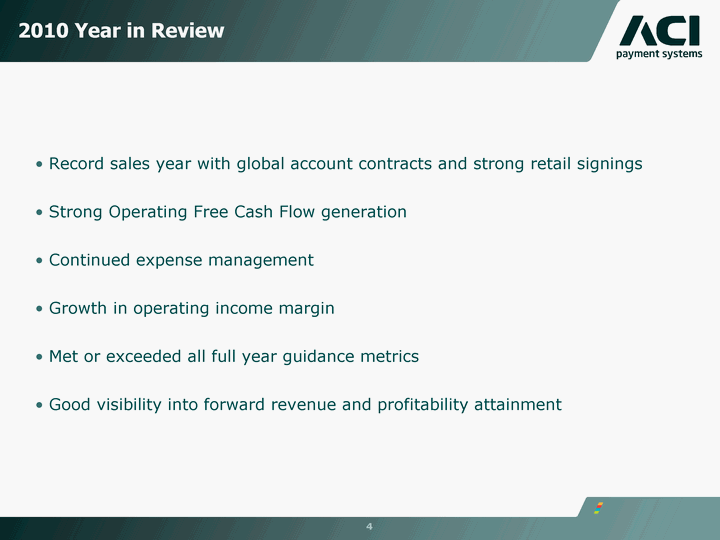
| 4 2010 Year in Review Record sales year with global account contracts and strong retail signings Strong Operating Free Cash Flow generation Continued expense management Growth in operating income margin Met or exceeded all full year guidance metrics Good visibility into forward revenue and profitability attainment |

| Business Overview Ralph Dangelmaier President, Global Markets |
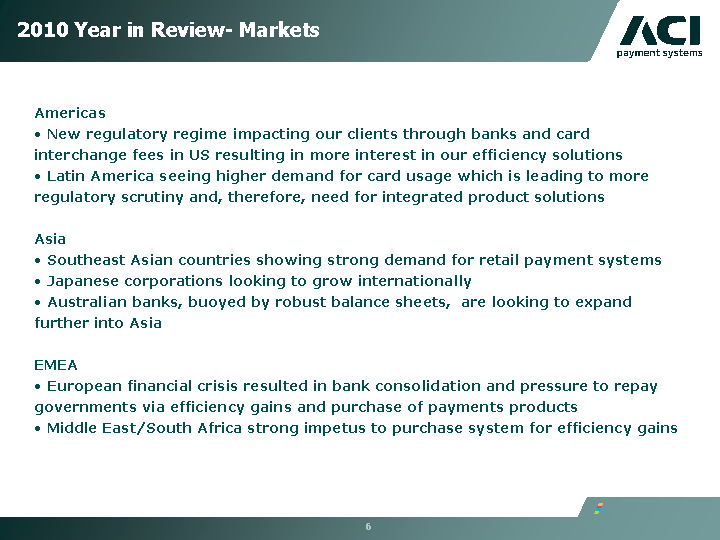
| 2010 Year in Review- Markets Americas New regulatory regime impacting our clients through banks and card interchange fees in US resulting in more interest in our efficiency solutions Latin America seeing higher demand for card usage which is leading to more regulatory scrutiny and, therefore, need for EMV-type solutions Asia Southeast Asian countries showing strong demand for retail payment systems Japanese corporations looking to grow internationally Australian banks, buoyed by robust balance sheets, are looking to expand further into Asia EMEA European financial crisis resulted in bank consolidation and pressure to repay governments via efficiency gains and purchase of payments products Middle East/South Africa strong impetus to purchase system for efficiency gains |
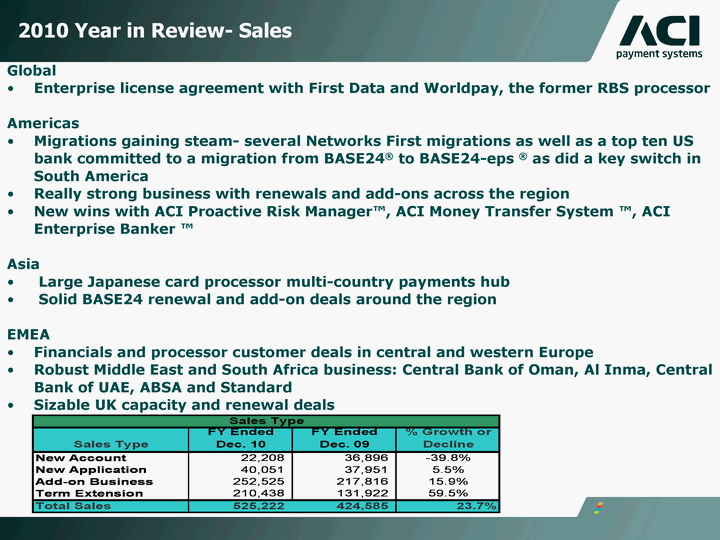
| 2010 Year in Review- Sales Global Enterprise license agreement with First Data and Worldpay, the former RBS processor Americas Migrations gaining steam- several Networks First migrations as well as a top ten US bank committed to a migration from BASE24(r) to BASE24-eps (r) as did a key switch in South America Really strong business with renewals and add-ons across the region New wins with ACI Proactive Risk Manager(tm), ACI Money Transfer System (tm), ACI Enterprise Banker (tm) Asia Large Japanese card processor multi-country payments hub Solid BASE24 renewal and add-on deals around the region EMEA Financials and processor customer deals in central and western Europe Robust Middle East and South Africa business: Central Bank of Oman, Al Inma, Central Bank of UAE, ABSA and Standard Sizable UK capacity and renewal deals |

| Q4 2010 Characterized by Sales Expansion in Renewals and Add-on Products Total quarterly sales remained constant over prior year driven by large UK and Japan sales Quarter characterized by new application sales as well as renewals with add-on sales - Major add-on PRM sale at a Southern European processor - Term extension with major Swiss credit card issuer - BASE24-eps migration sold to key Latin American customer - New BASE24-eps solution sold to large Middle East customer Two new North American accounts purchasing ACI On-Demand offerings BASE 24-eps migrations sales beginning to positively impact retail payments sales BASE24 renewals across Australia, Thailand, Philippines, South Korea and Sri Lanka 8 |
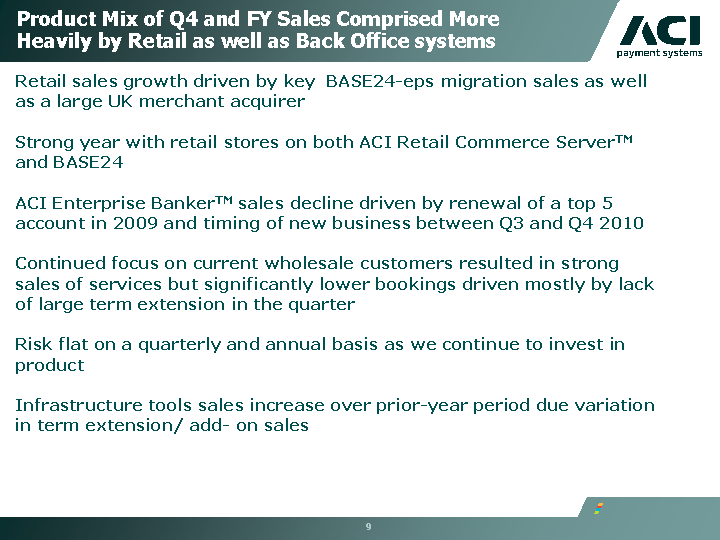
| 9 Product Mix of Q4 and FY Sales Comprised More Heavily by Retail as well as Back Office systems Retail sales growth driven by key BASE24-eps migration sales as well as a large UK merchant acquirer Strong year with retailers/big box stores on both ACI Retail Commerce ServerTM and BASE24 ACI Enterprise BankerTM sales decline driven by renewal of a top 5 account in 2009 and timing of new business between Q3 and Q4 2010 Continued focus on current wholesale customers resulted in strong sales of services but significantly lower bookings driven mostly by lack of large term extension in the quarter Risk flat on a quarterly and annual basis as we continue to invest in product Infrastructure tools sales increase over prior-year period due variation in term extension/ add- on sales timing |
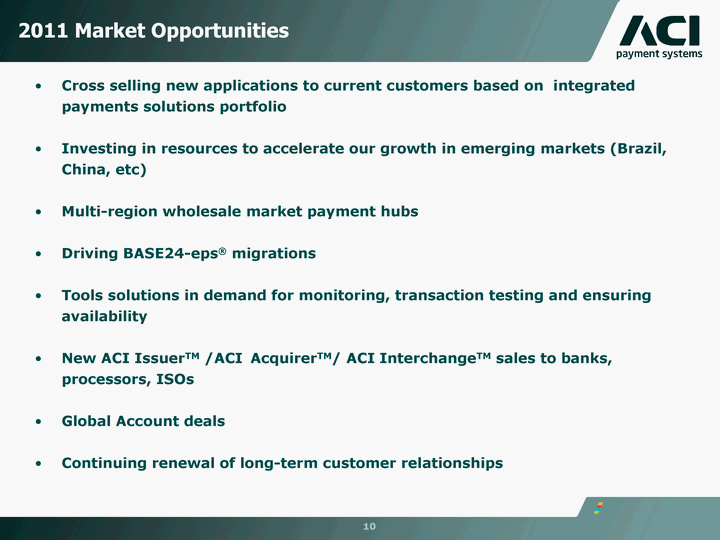
| 2011 Market Opportunities Cross selling new applications to current customers based on integrated payments solutions portfolio Investing in resources to accelerate our growth in emerging markets (Brazil, China, etc) Multi-region wholesale market payment hubs Driving BASE24-eps(r) migrations Tools solutions in demand for monitoring, transaction testing and ensuring availability New ACI IssuerTM /ACI AcquirerTM/ ACI InterchangeTM sales to banks, processors, ISOs Global Account deals Continuing renewal of long-term customer relationships |
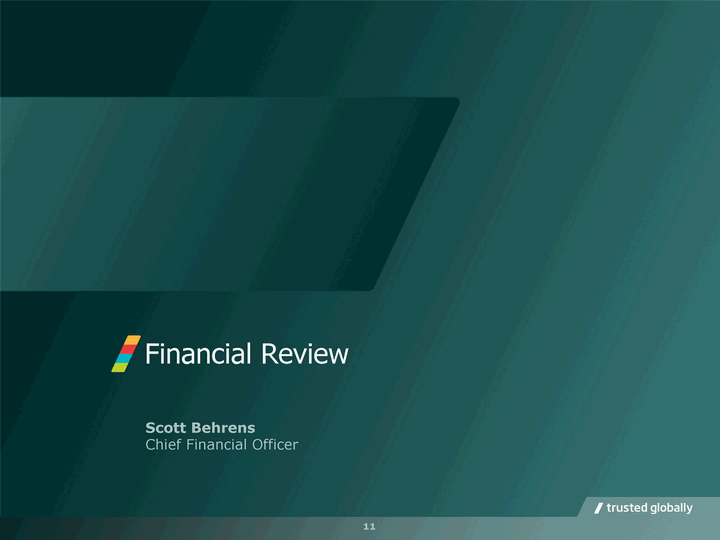
| Financial Review Scott Behrens Chief Financial Officer |

| Key Takeaways from the Quarter Record revenue quarter Led by strong growth in recurring revenue, up $16.7 million, or 26%, over prior-year quarter Balanced Sales Growth Strong sales growth in the EMEA and Asia regions as compared to Q4-09 Led by sales of new applications Another Strong Cash Quarter OFCF of $28.0 million compared to $29.8 million in Q4 2009 12 |
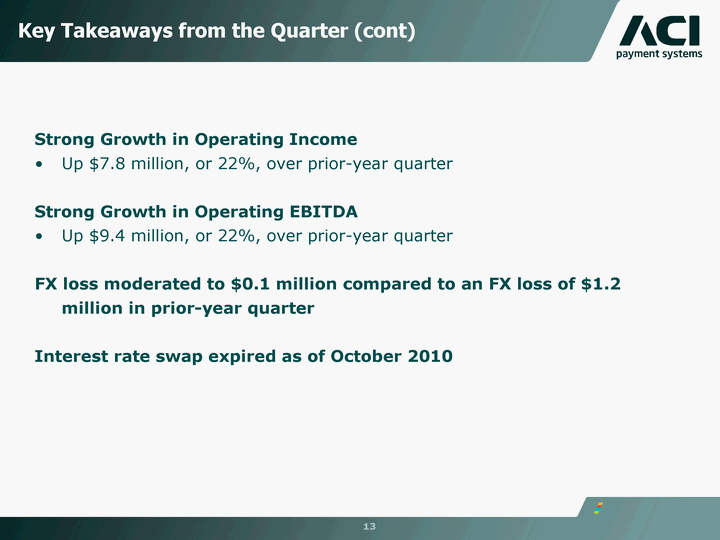
| 13 Key Takeaways from the Quarter (cont) Strong Growth in Operating Income Up $7.8 million, or 22%, over prior-year quarter Strong Growth in Operating EBITDA Up $9.4 million, or 22%, over prior-year quarter FX loss moderated to $0.1 million compared to an FX loss of $1.2 million in prior-year quarter Interest rate swap expired as of October 2010 |
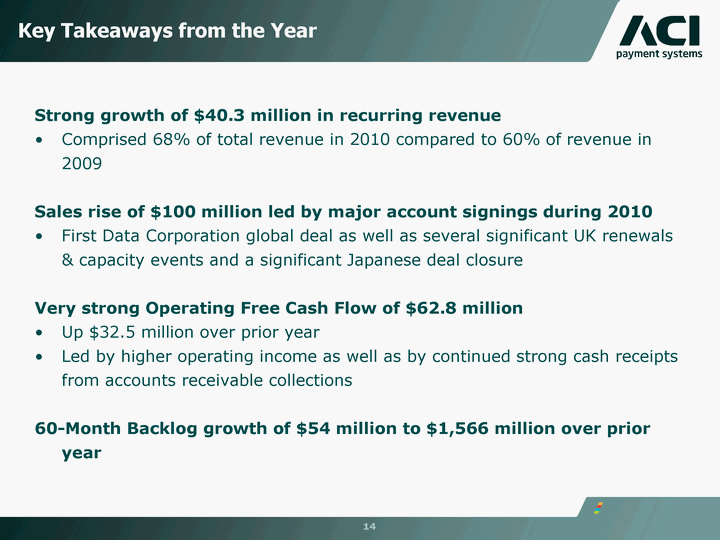
| Key Takeaways from the Year Strong growth of $40.3 million in recurring revenue Comprised 68% of total revenue in 2010 compared to 60% of revenue in 2009 Sales rise of $100 million led by major account signings during 2010 First Data Corporation global deal as well as several significant UK renewals & capacity events and a significant Japanese deal closure Very strong Operating Free Cash Flow of $62.8 million Up $32.5 million over prior year Led by higher operating income as well as by continued strong cash receipts from accounts receivable collections 60-Month Backlog growth of $54 million to $1,566 million over prior year |
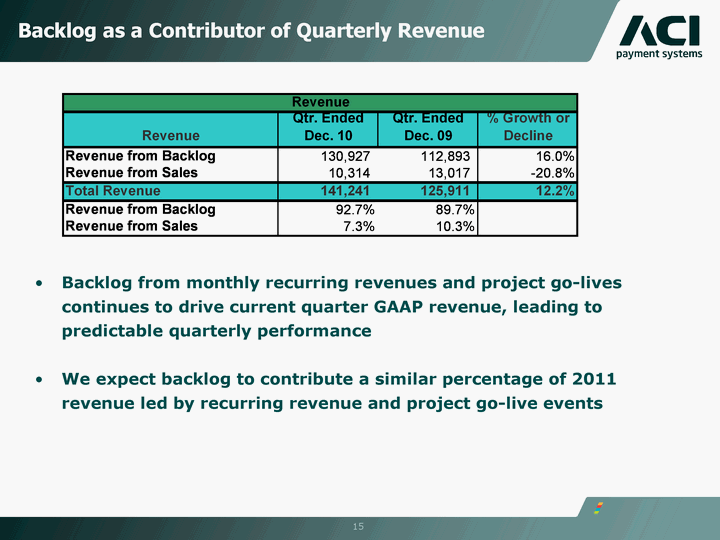
| Backlog as a Contributor of Quarterly Revenue Backlog from monthly recurring revenues and project go-lives continues to drive current quarter GAAP revenue, leading to predictable quarterly performance We expect backlog to contribute a similar percentage of 2011 revenue led by recurring revenue and project go-live events 15 |
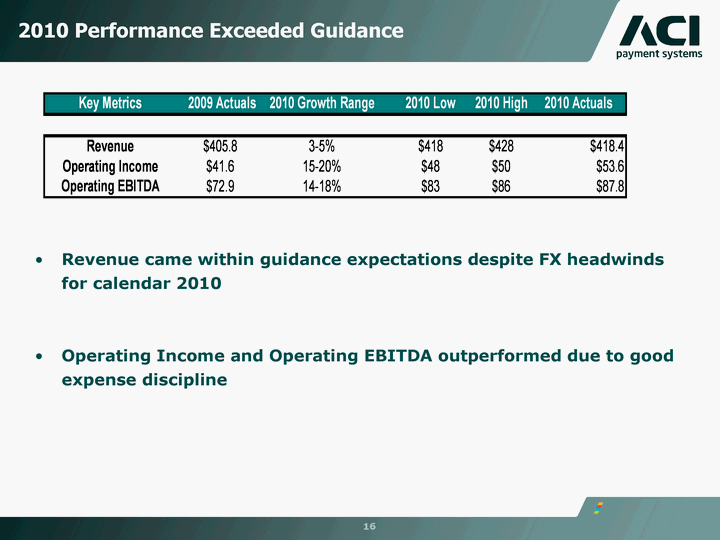
| 2010 Performance Exceeded Guidance Revenue came within guidance expectations despite FX headwinds for calendar 2010 Operating Income and Operating EBITDA outperformed due to good expense discipline |
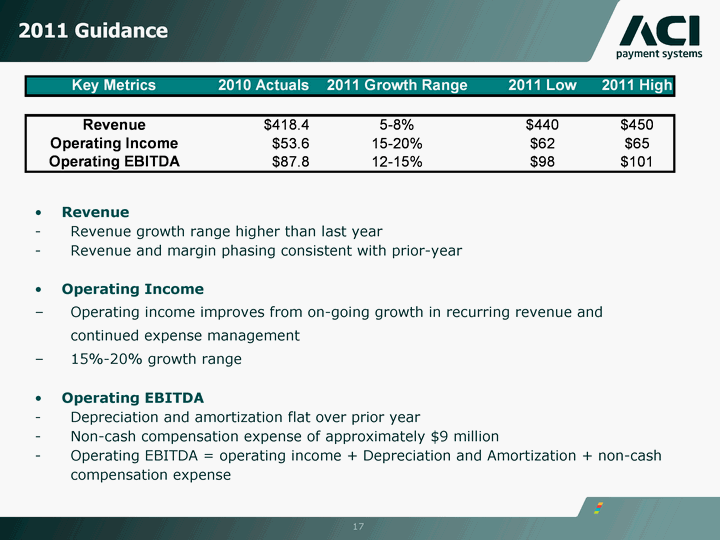
| 2011 Guidance 17 Revenue Revenue growth range higher than last year Revenue and margin phasing consistent with prior-year Operating Income Operating income improves from on-going growth in recurring revenue and continued expense management 15%-20% growth range Operating EBITDA Depreciation and amortization flat over prior year Non-cash compensation expense of approximately $9 million Operating EBITDA = operating income + Depreciation and Amortization + non-cash compensation expense |

| Other Factors Impacting Guidance Sales to be in the high $400s million OFCF growth consistent with Operating EBITDA growth Cash taxes expected to be lower than in 2010 Capex flat over prior-year 18 |

| Appendix |
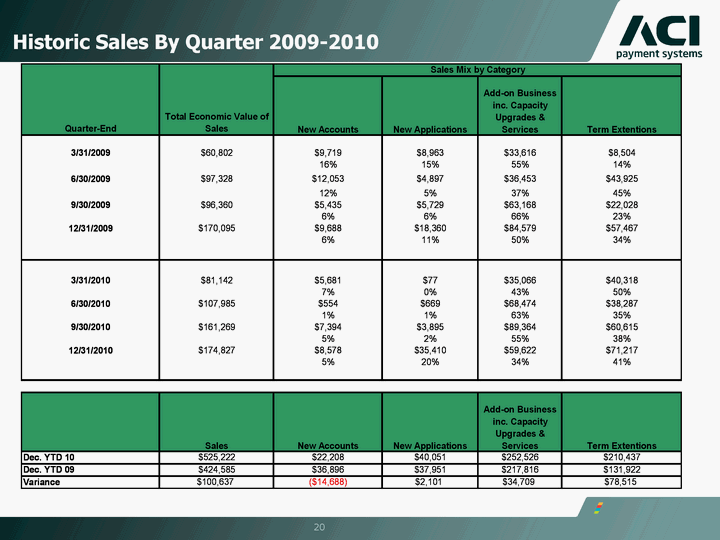
| 20 Historic Sales By Quarter 2009-2010 |
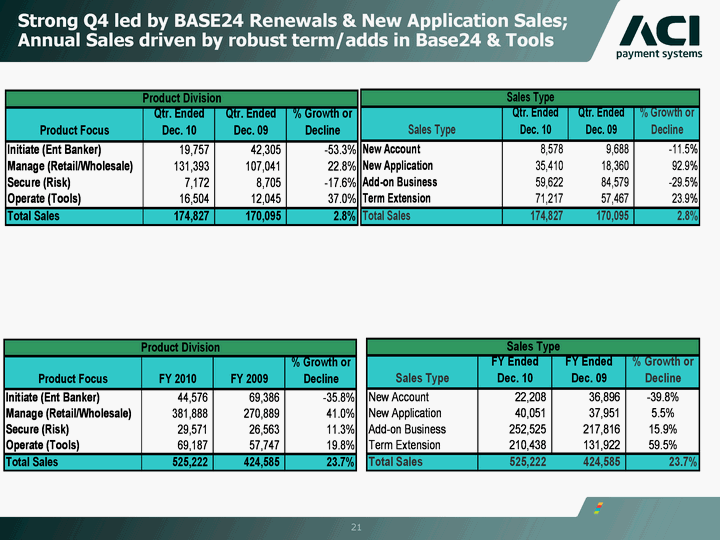
| 21 Strong Q4 led by BASE24 Renewals & New Application Sales; Annual Sales driven by robust term/adds in Base24 & Tools |
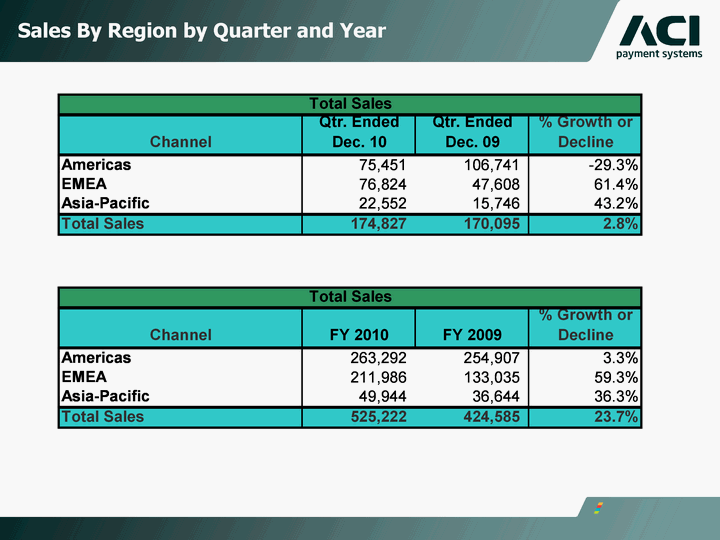
| Sales By Region by Quarter and Year |

| Operating Free Cash Flow ($ millions) 23 Quarter Ended December 31, Quarter Ended December 31, 2010 2009 Net cash provided by operating activities $32.2 $ 32.8 Adjustments: Net after-tax payments associated with employee-related actions - 1.3 Net after-tax payments associated with IBM IT Outsourcing Transition and Severance 0.2 - Less capital expenditures (2.6) (3.4) Less Alliance technical enablement expenditures (1.8) (0.9) Operating Free Cash Flow* $28.0 $29.8 *OFCF is defined as net cash provided (used) by operating activities, less net after-tax payments associated with employee-related actions and IBM IT outsourcing transition and severance, capital expenditures and plus or minus net proceeds from IBM. |
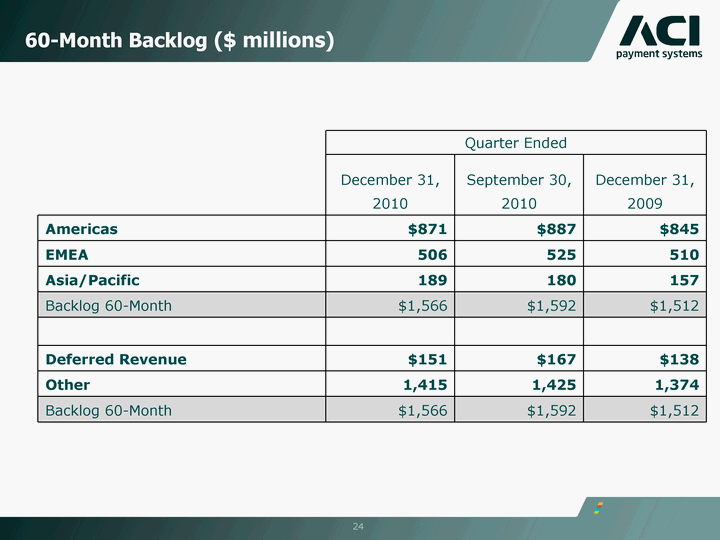
| 60-Month Backlog ($ millions) 24 Quarter Ended Quarter Ended Quarter Ended December 31, September 30, December 31, 2010 2010 2009 Americas $871 $887 $845 EMEA 506 525 510 Asia/Pacific 189 180 157 Backlog 60-Month $1,566 $1,592 $1,512 Deferred Revenue $151 $167 $138 Other 1,415 1,425 1,374 Backlog 60-Month $1,566 $1,592 $1,512 |

| Revenues by Channel ($ millions) 25 Quarter Ended December 31, Quarter Ended December 31, 2010 2009 Revenues: United States $54.8 $ 55.7 Americas International 20.3 12.3 Americas $75.1 $68.0 EMEA 53.1 43.2 Asia/Pacific 13.0 14.7 Revenues $141.2 $125.9 |
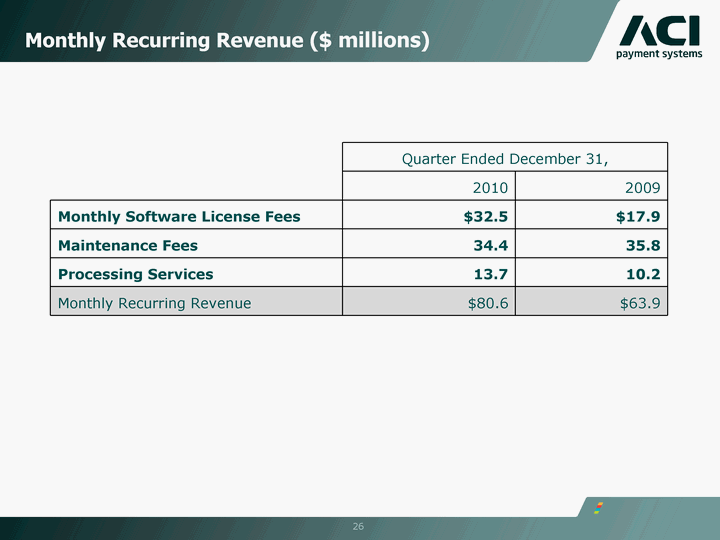
| Monthly Recurring Revenue ($ millions) 26 Quarter Ended December 31, Quarter Ended December 31, 2010 2009 Monthly Software License Fees $32.5 $17.9 Maintenance Fees 34.4 35.8 Processing Services 13.7 10.2 Monthly Recurring Revenue $80.6 $63.9 |
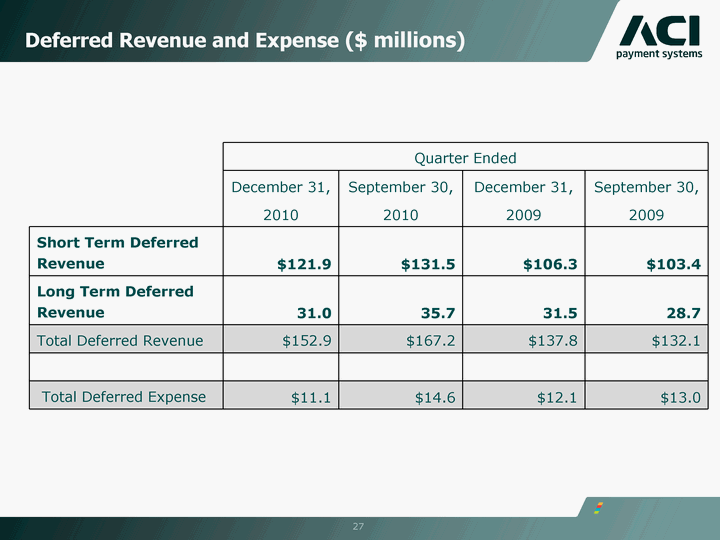
| Deferred Revenue and Expense ($ millions) 27 Quarter Ended Quarter Ended Quarter Ended Quarter Ended December 31, September 30, December 31, September 30, 2010 2010 2009 2009 Short Term Deferred Revenue $121.9 $131.5 $106.3 $103.4 Long Term Deferred Revenue 31.0 35.7 31.5 28.7 Total Deferred Revenue $152.9 $167.2 $137.8 $132.1 Total Deferred Expense $11.1 $14.6 $12.1 $13.0 |
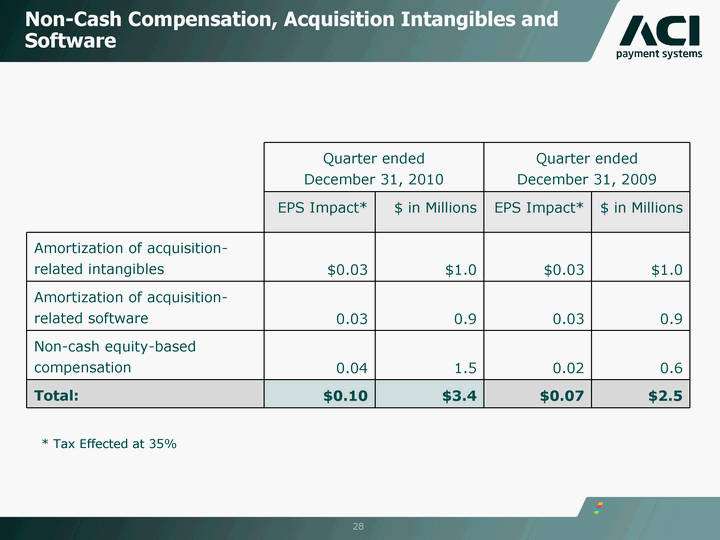
| Non-Cash Compensation, Acquisition Intangibles and Software 28 Quarter ended December 31, 2010 Quarter ended December 31, 2010 Quarter ended December 31, 2009 Quarter ended December 31, 2009 EPS Impact* $ in Millions EPS Impact* $ in Millions Amortization of acquisition-related intangibles $0.03 $1.0 $0.03 $1.0 Amortization of acquisition-related software 0.03 0.9 0.03 0.9 Non-cash equity-based compensation 0.04 1.5 0.02 0.6 Total: $0.10 $3.4 $0.07 $2.5 * Tax Effected at 35% |
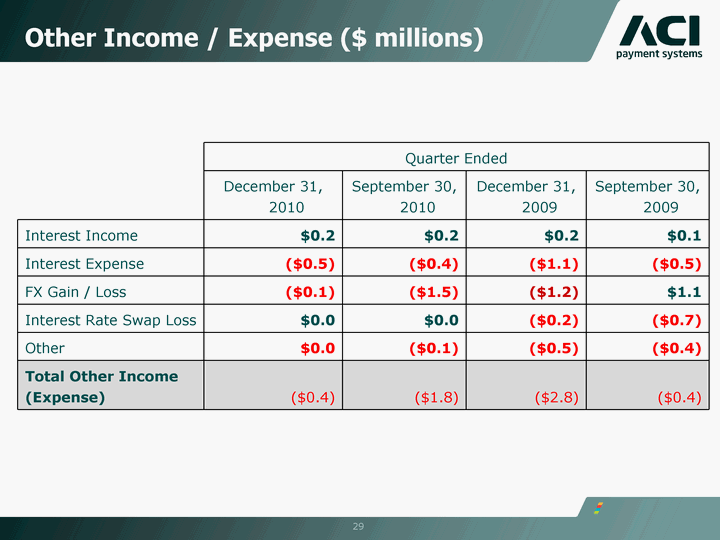
| Other Income / Expense ($ millions) 29 Quarter Ended Quarter Ended Quarter Ended Quarter Ended December 31, 2010 September 30, 2010 December 31, 2009 September 30, 2009 Interest Income $0.2 $0.2 $0.2 $0.1 Interest Expense ($0.5) ($0.4) ($1.1) ($0.5) FX Gain / Loss ($0.1) ($1.5) ($1.2) $1.1 Interest Rate Swap Loss $0.0 $0.0 ($0.2) ($0.7) Other $0.0 ($0.1) ($0.5) ($0.4) Total Other Income (Expense) ($0.4) ($1.8) ($2.8) ($0.4) |

| Operating EBITDA Quarter Ended December 31, 2010 Quarter Ended December 31, 2009 Operating Income $42.8 $35.0 Depreciation Expense 1.6 1.6 Amortization Expense 5.0 4.7 Non-Cash Compensation Expense 2.3 1.0 Operating EBITDA $51.7 $42.3 30 Operating EBITDA is defined as operating income plus depreciation, amortization and non-cash compensation. |

| Non-GAAP Financial Measures ACI is presenting operating free cash flow, which is defined as net cash provided (used) by operating activities, less net after-tax payments associated with employee related activities, net after-tax payments associated with IBM IT outsourcing transition and severance, and capital expenditures and plus or minus net proceeds from IBM. Operating free cash flow is considered a non- GAAP financial measure as defined by SEC Regulation G. We utilize this non- GAAP financial measure, and believe it is useful to investors, as an indicator of cash flow available for debt repayment and other investing activities, such as capital investments and acquisitions. We utilize operating free cash flow as a further indicator of operating performance and for planning investing activities. Operating free cash flow should be considered in addition to, rather than as a substitute for, net cash provided (used) by operating activities. A limitation of operating free cash flow is that it does not represent the total increase or decrease in the cash balance for the period. This measure also does not exclude mandatory debt service obligations and, therefore, does not represent the residual cash flow available for discretionary expenditures. We believe that operating free cash flow is useful to investors to provide disclosures of our operating results on the same basis as that used by our management. We also believe that this measure can assist investors in comparing our performance to that of other companies on a consistent basis without regard to certain items, which do not directly affect our ongoing cash flow. 31 |
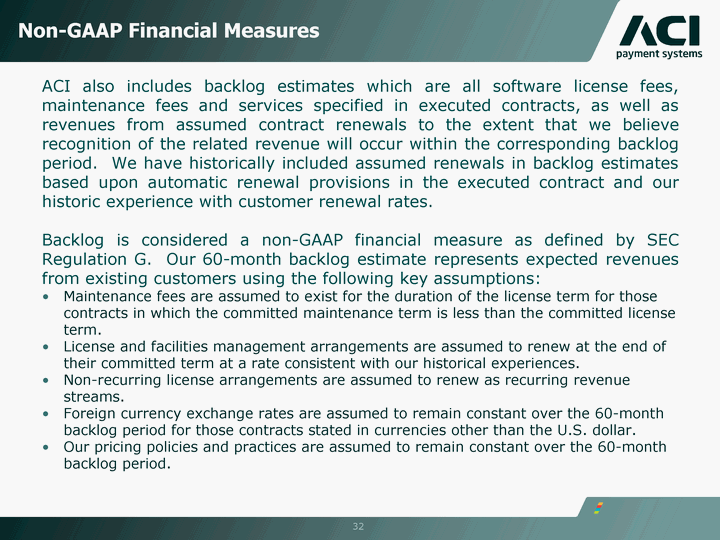
| Non-GAAP Financial Measures ACI also includes backlog estimates which are all software license fees, maintenance fees and services specified in executed contracts, as well as revenues from assumed contract renewals to the extent that we believe recognition of the related revenue will occur within the corresponding backlog period. We have historically included assumed renewals in backlog estimates based upon automatic renewal provisions in the executed contract and our historic experience with customer renewal rates. Backlog is considered a non-GAAP financial measure as defined by SEC Regulation G. Our 60-month backlog estimate represents expected revenues from existing customers using the following key assumptions: Maintenance fees are assumed to exist for the duration of the license term for those contracts in which the committed maintenance term is less than the committed license term. License and facilities management arrangements are assumed to renew at the end of their committed term at a rate consistent with our historical experiences. Non-recurring license arrangements are assumed to renew as recurring revenue streams. Foreign currency exchange rates are assumed to remain constant over the 60-month backlog period for those contracts stated in currencies other than the U.S. dollar. Our pricing policies and practices are assumed to remain constant over the 60-month backlog period. 32 |
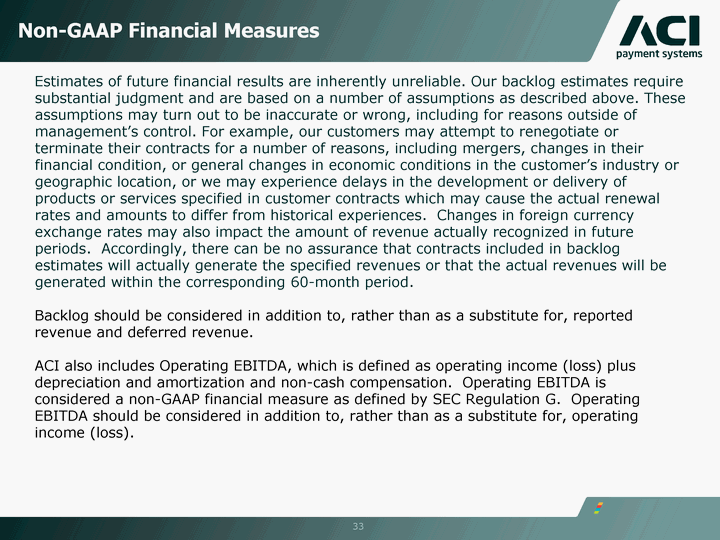
| Non-GAAP Financial Measures Estimates of future financial results are inherently unreliable. Our backlog estimates require substantial judgment and are based on a number of assumptions as described above. These assumptions may turn out to be inaccurate or wrong, including for reasons outside of management's control. For example, our customers may attempt to renegotiate or terminate their contracts for a number of reasons, including mergers, changes in their financial condition, or general changes in economic conditions in the customer's industry or geographic location, or we may experience delays in the development or delivery of products or services specified in customer contracts which may cause the actual renewal rates and amounts to differ from historical experiences. Changes in foreign currency exchange rates may also impact the amount of revenue actually recognized in future periods. Accordingly, there can be no assurance that contracts included in backlog estimates will actually generate the specified revenues or that the actual revenues will be generated within the corresponding 60-month period. Backlog should be considered in addition to, rather than as a substitute for, reported revenue and deferred revenue. ACI also includes Operating EBITDA, which is defined as operating income (loss) plus depreciation and amortization and non-cash compensation. Operating EBITDA is considered a non-GAAP financial measure as defined by SEC Regulation G. Operating EBITDA should be considered in addition to, rather than as a substitute for, operating income (loss). 33 |
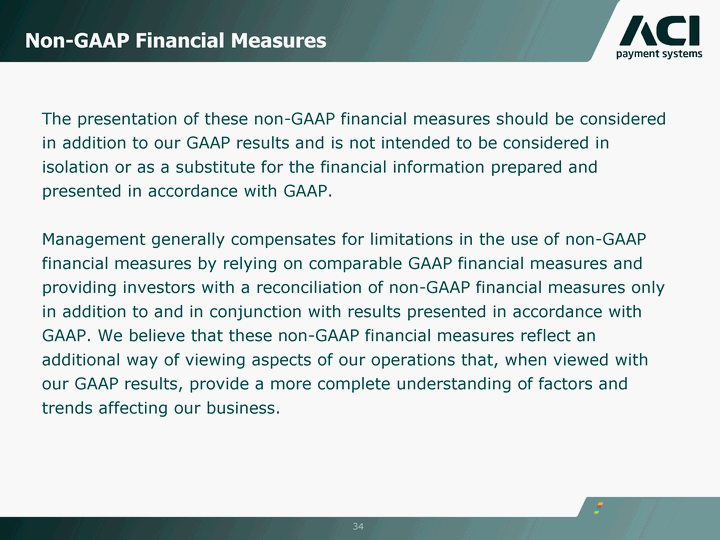
| Non-GAAP Financial Measures The presentation of these non-GAAP financial measures should be considered in addition to our GAAP results and is not intended to be considered in isolation or as a substitute for the financial information prepared and presented in accordance with GAAP. Management generally compensates for limitations in the use of non-GAAP financial measures by relying on comparable GAAP financial measures and providing investors with a reconciliation of non-GAAP financial measures only in addition to and in conjunction with results presented in accordance with GAAP. We believe that these non-GAAP financial measures reflect an additional way of viewing aspects of our operations that, when viewed with our GAAP results, provide a more complete understanding of factors and trends affecting our business. 34 |

| Forward-Looking Statements This presentation contains forward-looking statements based on current expectations that involve a number of risks and uncertainties. Generally, forward-looking statements do not relate strictly to historical or current facts and may include words or phrases such as "believes," " will," "expects," "anticipates," "intends," and words and phrases of similar impact. The forward-looking statements are made pursuant to safe harbor provisions of the Private Securities Litigation Reform Act of 1995. Forward-looking statements in this presentation include, but are not limited to, statements regarding: • Our belief that we have good visibility into forward revenue and profitability attainment; • Assumptions regarding our markets including expectations and assumptions relating to (i) the new regulatory regime impacting our clients through bank and card interchange fees in the US and resulting in more interest in our efficiency solutions, (ii) a higher demand for card usage in Latin America leading to more regulatory scrutiny and the need for EMV-type solutions, (iii) a strong demand for retail payments systems in Southeast Asia, (iv) the desire of Japanese corporations to grow internationally, (v) the desire of Australian banks to expand further into Asia, (vi) banks impacted by the European financial crisis feeling pressure to repay governments via efficiency gains and purchase of payments products, and (vii) a strong impetus in the Middle East/South Africa to purchase systems for efficiency gains; • Our belief that BASE24-eps migrations are gaining steam; • Our belief that BASE24-eps migrations sales are beginning to positively impact retail payment sales; • Expectations related to 2011 market opportunities including expectations and assumptions regarding (i) cross selling new applications to current customers based on an integrated payments solutions portfolio, (ii) investment in resources to accelerate growth in emerging markets including Brazil and China, (iii) multi-region wholesale market payment hubs, (iv) driving BASE24-eps migrations, (v) tools solutions in demand for monitoring, transaction testing and ensuring availability, (vi) new sales of ACI Issuer, ACI Acquirer and ACI Interchange to banks, processors and ISOs, (vii) global account deals, and (viii) continuing renewal of long-term customer relationships; •The company's 12-month and 60-month backlog estimates and assumptions, including (i) our belief that backlog from monthly recurring revenues and project go-lives will continue to drive current quarter GAAP revenue and lead to predictable quarterly performance, and (ii) expectations for backlog to contribute a similar percentage of 2011 revenue led by recurring revenue and project go-live events as it did in 2010; and • Expectations regarding 2011 financial guidance related to revenue, operating income and operating EBITDA and assumptions regarding other factors impacting our 2011 financial guidance, including sales and operating free cash flow. 35 |
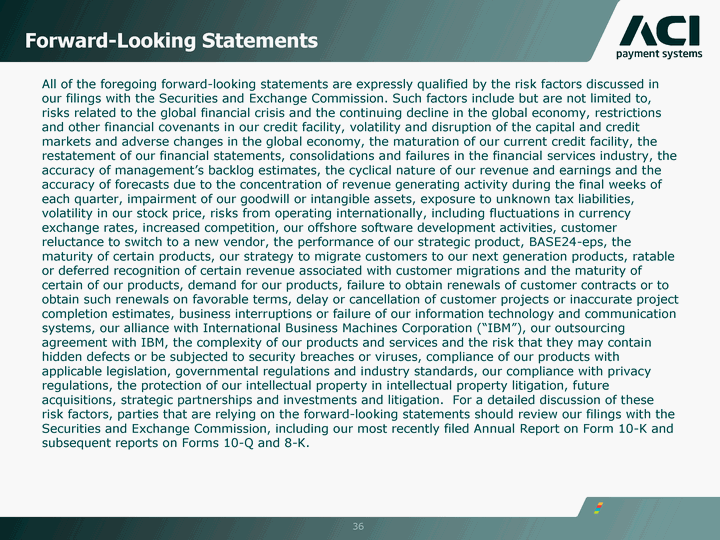
| Forward-Looking Statements All of the foregoing forward-looking statements are expressly qualified by the risk factors discussed in our filings with the Securities and Exchange Commission. Such factors include but are not limited to, risks related to the global financial crisis and the continuing decline in the global economy, restrictions and other financial covenants in our credit facility, volatility and disruption of the capital and credit markets and adverse changes in the global economy, the maturation of our current credit facility, the restatement of our financial statements, consolidations and failures in the financial services industry, the accuracy of management's backlog estimates, the cyclical nature of our revenue and earnings and the accuracy of forecasts due to the concentration of revenue generating activity during the final weeks of each quarter, impairment of our goodwill or intangible assets, exposure to unknown tax liabilities, volatility in our stock price, risks from operating internationally, including fluctuations in currency exchange rates, increased competition, our offshore software development activities, customer reluctance to switch to a new vendor, the performance of our strategic product, BASE24-eps, the maturity of certain products, our strategy to migrate customers to our next generation products, ratable or deferred recognition of certain revenue associated with customer migrations and the maturity of certain of our products, demand for our products, failure to obtain renewals of customer contracts or to obtain such renewals on favorable terms, delay or cancellation of customer projects or inaccurate project completion estimates, business interruptions or failure of our information technology and communication systems, our alliance with International Business Machines Corporation ("IBM"), our outsourcing agreement with IBM, the complexity of our products and services and the risk that they may contain hidden defects or be subjected to security breaches or viruses, compliance of our products with applicable legislation, governmental regulations and industry standards, our compliance with privacy regulations, the protection of our intellectual property in intellectual property litigation, future acquisitions, strategic partnerships and investments and litigation. For a detailed discussion of these risk factors, parties that are relying on the forward-looking statements should review our filings with the Securities and Exchange Commission, including our most recently filed Annual Report on Form 10-K and subsequent reports on Forms 10-Q and 8-K. 36 |
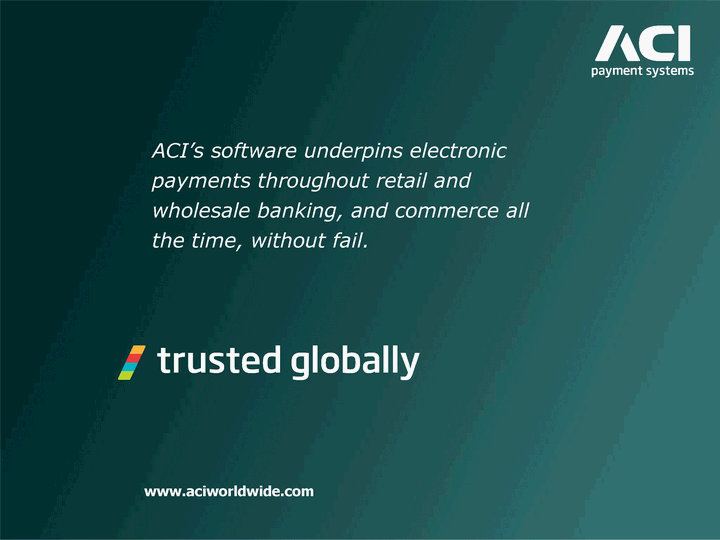
| ACI's software underpins electronic payments throughout retail and wholesale banking, and commerce all the time, without fail. www.aciworldwide.com |
